 |
Focus features two in-depth reviews each month of fine art, architecture and design exhibitions and events at art museums, galleries and alternative spaces around Japan. The contributors are non-Japanese art critics living in Japan. |
|
|
 |
 |
 |
Sleep Inside a Work of Art: BnA Hotel Koenji
Michael Pronko |
 |
The Japanese wolves yelping across the walls might give the faint of heart bad dreams, but the energy of this work by Yohei Takahashi is beguiling. Besides painting on the walls, Takahashi designed the shape of the room and all the fixtures. |
|
Ryuichi Ogino's "Ten" is a lively work that creates tension between brash shapes and energetic yet still soothing colors. The entire room is suffused with various kinds and hues of light. |
Viewing art on the walls of museums and galleries is different from being completely surrounded by a work of art, much less drifting off to sleep inside it. At the newly completed BnA Hotel Koenji, visitors can do exactly that. To view the art, you cannot just go inside, you have to spend the night. BnA, which stands for "Bed and Art" (a play on Airbnb), offers rooms for the artistically inclined and culturally interested visitor to Tokyo, or for anyone who wants to be cocooned inside unique artwork overnight.
The two featured rooms are more than just art on the walls: the shapes and forms of the interiors are designed from scratch. Each room is given over to one artist, who works with an interior architect and designer to get every detail of the space worked out and unified by an artistic vision. The hotel managers, a group of young entrepreneurs, took a small, no-frills building near Koenji Station, on Tokyo's west side, and transformed it into an oasis of urban art. To make the project part of the local community, the artists are chosen from those with roots in Koenji's thriving arts and culture scene.
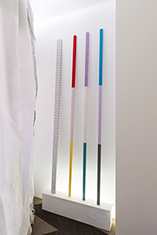 |
|
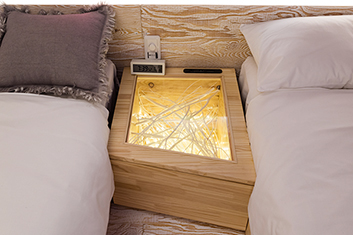 |
|
The beauty is in the details. Ryuichi Ogino uses every bit of space to add creativity and artistry to the experience of staying in the room he designed. |
|
The small campfire below the wolves in Yohei Takahashi's room serves as a cozy reminder of other journeys in the distant past. |
The second-floor room, titled "Into the Foreign," was created by Yohei Takahashi, an artist who has worked on other public art as well as live painting. The room contains many interlocking ideas, but the brightly colored wolves hurtling across the walls are what first grab one's attention. Though Japanese wolves have been extinct for over a century, the work brings back their spirit and intensity to surround the visitor. Between the beds is a table that recalls a campfire, made with white branches and soft lighting.
The third-floor room, created by Ryuichi Ogino, is called "Ten." That title might suggest many meanings, but they revolve around what he describes in his other exhibitions as an "idealistically hypocritical" approach based on his concept of "Out of Context Mash-Up." The room does indeed mash up shapes, colors and textures, but they still come together in the lush calm that infuses the interior. The main color is yellow, broken up by white and silver -- a very different kind of motion from the wolves. The color scheme is created by white light reflecting off yellow surfaces, while sharp edges contrast with circular shapes to generate tension and energy.
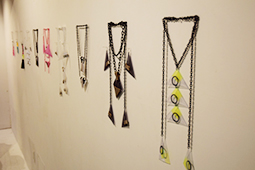 |
|
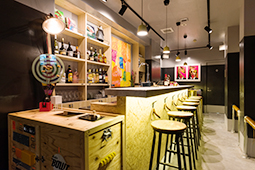 |
|
Mieko Kawasaki was in residence, showing her work in the basement gallery, which has a workbench set up in the middle of the room and a sound system ready for the opening. |
|
The lobby has no need of a check-in counter; instead visitors can get right into the art and start relaxing as soon as they arrive. |
The two rooms are entirely different, one free-flowing with expansive, expressive brushwork and the other a precise, abstract work composed of sharp, clear lines. Yet both spaces feel complete and encompassing, providing a total interior experience to match the experience of visiting Tokyo. Part of the concept of the hotel is to bring tourists from outside Japan together with Japanese artists and designers. At the same time they give part of the profits of the hotel back to the artists, making this a sharing rather than owning model of art and economics.
|
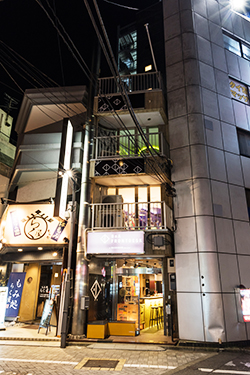 |
|
|
|
The hotel is part of the surrounding community, artfully concealing its unique interior and blending in modestly with the lively area around Koenji Station. |
Downstairs at BnA is a basement gallery that hosts a rotating residency program for up-and-coming artists, who are invited to work on an installation for ten days and then exhibit their work for 20 days. The current artist is Mieko Kawasaki, whose latest project involves using delicate, light materials to make jewelry and accessories. A sound system for a DJ stands ready for openings and parties in the space. Even the lobby is unique. It shuns the standard hotel check-in counter in favor of a sushi bar design, ready with light snacks and drinks for a suitable welcome to the art rooms.
The managers of BnA are planning connections to other galleries in the Koenji area, with the possibility of a "First Friday" art crawl from gallery to gallery. BnA is also planning to expand to other buildings in the future. The hallways of the hotel will be the small backstreets of Koenji as rooms are added here and there in the neighborhood. BnA hopes not just to build a solid tourist economy, but to further encourage the Koenji-wide art community. Those hopes look to be well on the way to fruition.
|
Photographs by Dairo Koga, courtesy of BnA Hotel Koenji.
|
 |
| | BnA Hotel Koenji |
| | 2-4-7 Koenji-Kita, Suginami-ku, Tokyo
Contact: info@bna-hotel.com
Access: BnA Hotel Koenji is a one-minute walk from the north exit of Koenji Station on the JR Chuo and Sobu Lines, 10 to 15 minutes west of Shinjuku Station. |
|
 |
 |
Michael Pronko
Michael Pronko teaches American literature, film, art and music at Meiji Gakuin University. He has appeared on NHK, Sekai Ichiban Uketai Jugyo, and other TV programs. His publications include several textbooks and three collections of essays about Tokyo. He writes regular columns for Newsweek Japan, ST Shukan, The Japan Times, and for his own websites, Jazz in Japan and Essays on English in Japan. |
|
 |
|